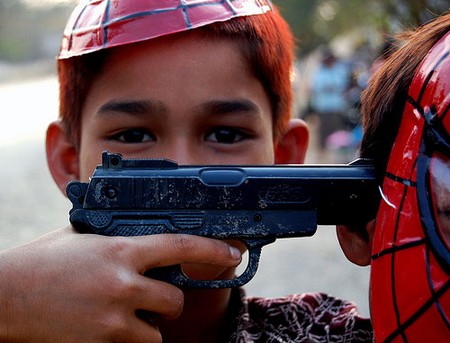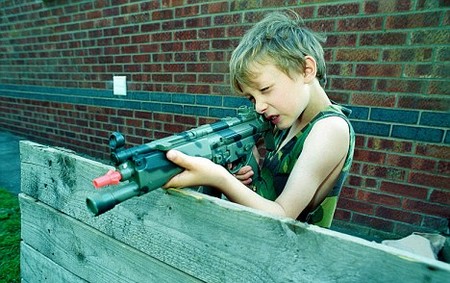Many moms and dads lament the fact that little boys, in particular, love to turn every object they touch into a weapon, from baseball bats to carrots, often imitating what they see on TV (with boys being more affected by violent TV than girls). Young children do not process information the same way as adults, nor do they have the tools to evaluate what they see.
It has been reported that preschoolers who were given guns and other violent toys to play with acted more aggressively than preschoolers who only watched a television program with violent content. But studies have shown that by the age of three, children will imitate someone on TV as readily as they will a real person. The results of the studies on the effects of viewing television violence are consistent: Children learn how to be aggressive in new ways and draw conclusions about whether being aggressive will bring them rewards.

Those children who see television characters getting what they want by using weapons are more likely to imitate those acts themselves. If parents ignore or approve of their children’s use of weapons or exhibit violent behavior themselves, they serve as role models for their children. On the other hand, parents who show their children how to solve problems nonviolently and who consistently praise their children for finding peaceful solutions to conflicts show their children how to be less aggressive. So when your preschooler makes pretend guns out of French fries, don’t panic, but don’t ignore his imaginative play either. Instead, teach the important lesson that even pretending to physically hurt people can hurt their feelings. Keep in mind that the behavior of the adults closest to a child encourages him to be kind or cruel. Watch what you do and say, and how “explosively” you act, in order to help curb your child’s appetite for violent play.
Preventing the Problems
Make caring a household rule.
When your child behaves aggressively, make a rule that tells him what is or isn’t allowed regarding pretending to use toys in violent ways. For example, say, “The rule is we treat people nicely to show them that we care. Pointing guns, even pretend ones, is against our rules because it hurts people’s feelings and makes them afraid.”
Think before speaking.
Use words and a tone of voice that you wouldn’t mind your child repeating. For example, when he breaks a rule, instead of threatening (even in jest) to “knock his head off if he doesn’t stop,” calmly say, “I’m sorry you decided not to follow the rule about pretending to use a gun. The rule is, ‘We treat each other nicely and don’t ever hurt or pretend to hurt anyone.'”
Model kindness.
You are your child’s first and most important role model. When you listen to, hug, apologize to, and respect your child, he will learn to behave in kind.
Learn to control your anger.
What causes children to “go off” is the same thing that causes adults to explode; anger over something beyond their control. Tell yourself you hope you get a raise, hope the traffic is light, hope your favorite dress still fits, and so on. But if none of these wishes comes true, don’t have a meltdown. By keeping your cool, you set a powerful example for your child of maintaining self-control when things don’t go your way.
Solving the Problem
What to Do
Teach empathy.
When your child pretends to attack another person with a toy gun or other object, consider this a teachable moment. Ask him to think about how it would feel to be shot by a pretend gun. Say, “Guns can hurt people. How would you feel if someone acted as if he were going to shoot you? I wouldn’t want to scare or hurt anyone. I hope you wouldn’t want to, either.”
Encourage cooperative play.
Children who learn to enjoy building things, sharing with others, and engaging in supervised social activities will have less opportunity to resort to violent games for entertainment. Praise your preschooler when he’s getting along with others while playing, so he knows you approve of his playing nicely. Say, “I like the way you’re getting along and being kind to each other by sharing toys.”
Restrict violent TV and video/computer games.
It’s well documented that preschoolers like to imitate what they see. Many children have been victimized by kung fu kicks being tried out by playmates. In one Canadian study, children were found to be significantly more aggressive two years after TV was first introduced to their town. Strong identification with a violent television character and believing that the television situation is realistic are both associated with greater aggressiveness.
You need to know what your child is watching and what games he’s playing. Reduce the amount of violent content your child is exposed to by making a rule about what he can watch or what games he can play as well as how long he can watch or play. Put yourself in charge of the television remote control and the computer power switch, to keep violence out of your home and out of your child’s imagination.
When your child watches TV, watch with him.
Studies have shown that when an adult watches TV with a child and comments on the action, children remember more and are more likely to imitate what they’ve seen. Because watching TV with an adult may actually intensify the positive (or negative) effect of the content on children, it’s imperative that you select only nonviolent shows for your child’s viewing and discuss the content with him. Your child should not watch with you if you’re watching violent TV.
Teach your child to make amends.
When an overly exuberant tot tries to “shoot” a sibling or playmate with a ruler, for example, take away the “weapon” and say, “Guns hurt people. The rule is that we treat each other kindly and never even pretend to hurt another person. We don’t hurt people; we love people. Please tell Sam you’re sorry for pointing a gun at him.” When your child follows your directions, say, “Thank you for being Sam’s friend. I like the way you’re showing him you care about him.”
Teach your child to compromise.
Help your child learn to be fair when resolving disputes. When you see him threatening to hit his friend for taking his toy, for example, say, “Let’s think about what else you could do when your friend takes your toy and you want it back. You could get the timer and set it like I do so your friend can play with the toy for a while and then you can play with it. That way both of you get to play with it and have fun.”
What Not to Do
Don’t hit?
No matter how tempting it is to spank a child to “smack some sense into him” or “teach him a lesson” resist the urge. Although you may be angry and scared when your child crosses the street without your permission, spanking him for doing so sends him a mixed message: It’s okay for me to hit you, but not for you to hit me or anyone else. Practice what you preach. Spanking teaches him it’s okay to hurt people to get them to do what you want. Even the occasional swat on the behind sends the hurtful message that if you’re bigger and stronger, it’s okay to hit to make a point.

Avoid overreacting.
When your child pretends to shoot his little brother with his pencil, for example, remain calm. Instead of simply forbidding the behavior, take advantage of a teachable moment by saying, “I’m sorry you broke the rule about treating people kindly. Tell me the rule and show me how you can treat your brother kindly now.
Don’t threaten.
Threatening to hit your child with a wooden spoon when he’s pretending to hit his sister with his stuffed animal only teaches him to fear your presence. To your child, a threat is an empty promise and an example of how adults don’t keep their word. Instead of threatening a violent consequence such as, “I’ll give you a spanking if I see you pretending to shoot your brother with that empty paper towel roll again,” simply say, “I’m sorry you chose to break our rule about pretending to hurt someone. Now I want you to think about how scared you’d feel if somebody pointed a gun at you.”